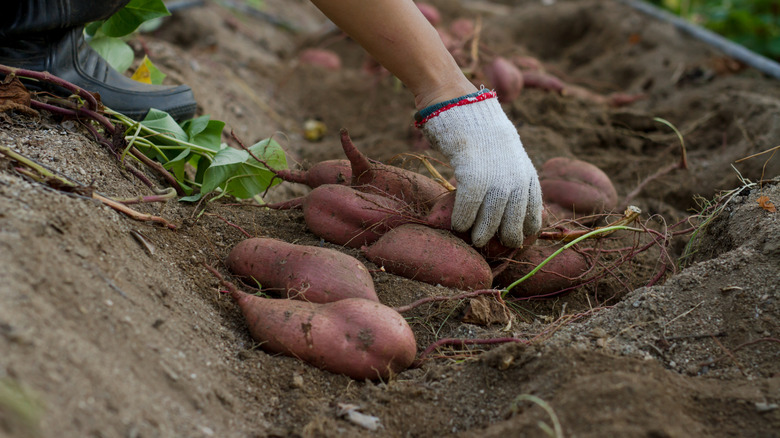You Can Grow Sweet Potatoes From The Comfort Of Your Home. Here's How
If you've ever planted potatoes in the fall, you know that growing tubers is a remarkably hands-off experience that reliably yields a great crop. Well, good news! According to Michael Clarke, horticulturist and founder of Yardwork, potatoes' sweeter cousins are plenty easy to grow in your own home.
"The best way to grow sweet potatoes indoors is to use slips instead of seeds or whole tubers," Clarke said. "Slips are the sprouts that grow from a mature sweet potato, becoming a plant that produces a new crop of tubers." Actual sweet potato seeds are quite rare, and while planting whole tubers may work, this takes up far more soil space than a slip. Clarke also recommended using an organic sweet potato to avoid any growth inhibitors, giving you the best possible veggie.
Cultivating slips from a sweet potato is quite easy, provided you have the right area for it. "Suspend half the tuber in water using toothpicks in a glass jar, cut side down. Place it in a warm, bright spot and wait 2 [to] 4 weeks for sprouts to emerge," explained Clarke. Once they're about six or eight inches long, just twist them off and you're ready to start planting. Be sure to prep your garden ahead of time, as sweet potatoes have a few more growing requirements than regular potatoes.
How to plant and grow sweet potatoes
Most popular root vegetables are fairly easy to grow, provided you have the right soil, light, and temperatures to cultivate them in. Whether you opt for a container, raised bed, or in-ground growing operation, sweet potatoes mostly just need a bit of watering and maybe some pest control every now and again to thrive.
"They require 10 [to] 12 hours of bright light daily from a south-facing window, greenhouse, or LED grow lights," said Michael Clarke. "Without enough light, you'll get leggy vines and poor tuber development." When it comes to soil, a great sweet potato crop actually needs fewer nutrients than you'd think and a pH balance between 5.5 and 6.8. Too much nitrogen-rich fertilizer causes their leaves to grow beautifully, and the actual tubers to develop poorly. You can use eggshells to fertilize your garden and lower its pH or use coffee to bump up the acidity, depending on your needs.
Clarke explained that sweet potatoes also like consistently moist soil as they grow, drying out slightly just before harvesting, so their tubers develop properly. Provided you leave enough room for their vines to sprawl, you should have a nice crop ready within three or four months. In the garden, yellowing leaves are a great sign that they're almost ready, Clarke told us. If you grow in containers, they should be noticeably heavier, signaling that the root system has developed enough to produce some great vegetables.


